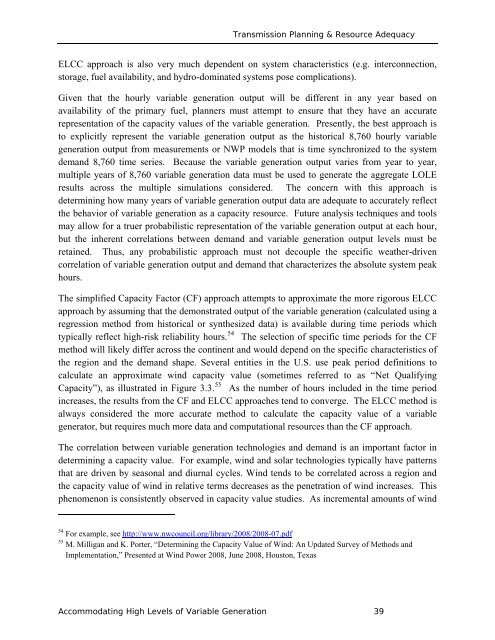Accommodating High Levels of Variable Generation - NERC
Accommodating High Levels of Variable Generation - NERC
Accommodating High Levels of Variable Generation - NERC
Create successful ePaper yourself
Turn your PDF publications into a flip-book with our unique Google optimized e-Paper software.
Transmission Planning & Resource Adequacy<br />
ELCC approach is also very much dependent on system characteristics (e.g. interconnection,<br />
storage, fuel availability, and hydro-dominated systems pose complications).<br />
Given that the hourly variable generation output will be different in any year based on<br />
availability <strong>of</strong> the primary fuel, planners must attempt to ensure that they have an accurate<br />
representation <strong>of</strong> the capacity values <strong>of</strong> the variable generation. Presently, the best approach is<br />
to explicitly represent the variable generation output as the historical 8,760 hourly variable<br />
generation output from measurements or NWP models that is time synchronized to the system<br />
demand 8,760 time series. Because the variable generation output varies from year to year,<br />
multiple years <strong>of</strong> 8,760 variable generation data must be used to generate the aggregate LOLE<br />
results across the multiple simulations considered. The concern with this approach is<br />
determining how many years <strong>of</strong> variable generation output data are adequate to accurately reflect<br />
the behavior <strong>of</strong> variable generation as a capacity resource. Future analysis techniques and tools<br />
may allow for a truer probabilistic representation <strong>of</strong> the variable generation output at each hour,<br />
but the inherent correlations between demand and variable generation output levels must be<br />
retained. Thus, any probabilistic approach must not decouple the specific weather-driven<br />
correlation <strong>of</strong> variable generation output and demand that characterizes the absolute system peak<br />
hours.<br />
The simplified Capacity Factor (CF) approach attempts to approximate the more rigorous ELCC<br />
approach by assuming that the demonstrated output <strong>of</strong> the variable generation (calculated using a<br />
regression method from historical or synthesized data) is available during time periods which<br />
typically reflect high-risk reliability hours. 54 The selection <strong>of</strong> specific time periods for the CF<br />
method will likely differ across the continent and would depend on the specific characteristics <strong>of</strong><br />
the region and the demand shape. Several entities in the U.S. use peak period definitions to<br />
calculate an approximate wind capacity value (sometimes referred to as “Net Qualifying<br />
Capacity”), as illustrated in Figure 3.3. 55 As the number <strong>of</strong> hours included in the time period<br />
increases, the results from the CF and ELCC approaches tend to converge. The ELCC method is<br />
always considered the more accurate method to calculate the capacity value <strong>of</strong> a variable<br />
generator, but requires much more data and computational resources than the CF approach.<br />
The correlation between variable generation technologies and demand is an important factor in<br />
determining a capacity value. For example, wind and solar technologies typically have patterns<br />
that are driven by seasonal and diurnal cycles. Wind tends to be correlated across a region and<br />
the capacity value <strong>of</strong> wind in relative terms decreases as the penetration <strong>of</strong> wind increases. This<br />
phenomenon is consistently observed in capacity value studies. As incremental amounts <strong>of</strong> wind<br />
54 For example, see http://www.nwcouncil.org/library/2008/2008-07.pdf<br />
55 M. Milligan and K. Porter, “Determining the Capacity Value <strong>of</strong> Wind: An Updated Survey <strong>of</strong> Methods and<br />
Implementation,” Presented at Wind Power 2008, June 2008, Houston, Texas<br />
<strong>Accommodating</strong> <strong>High</strong> <strong>Levels</strong> <strong>of</strong> <strong>Variable</strong> <strong>Generation</strong> 39
















